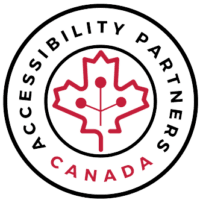The AODA refers to the Accessibility for Ontarians with Disabilities Act which is an accessibility law that requires both individuals and organizations to follow accessibility standards in both public and private sectors.
In today’s world, websites must communicate important information to their users, such as information on products and services, promotions, new events, etc. So naturally, you want to ensure your content reaches your target audience, barrier-free.
In 2005, The Accessibility for Ontarians with Disabilities Act (AODA) was created to enforce this barrier-free access to information and communication for all Ontarians who rely on accessibility features to use the web accurately.
Over the next 20 years, as the population ages, the number will rise to one in five Ontarians. More than half of the population has a friend or a loved one with a disability and is influenced by them when deciding which businesses to solicit. Making AODA compliance requirements for your website is not only the right thing to do but a smart thing to do.
What is AODA compliance in Ontario?
Before we dive into various AODA compliance requirements, it’s important to understand the basics of the accessibility law.
Ontario previously had an accessibility act called the Ontarians with Disabilities Act back in 2001. As time progressed, people with disabilities and individuals within the disability community offered their insights and recommendations to improve the act’s relevancy to society’s standards. To adjust to the new standards, a committee of people from various sectors developed The Accessibility for Ontarians with Disabilities Act (AODA) in 2005.
According to the AODA, there are five distinct sectors of the economy that organizations must consider and prioritize for people with disabilities.
- Information and communications — every obligated organization shall provide or arrange for the provision of accessible formats and communication support. This also includes preparing emergency procedures, plans, or public safety information and making this information available in accessible formats. All large organizations are required to make their websites and web content fully accessible by 1st January 2021. Ministry of Seniors and Accessibility is enforcing this through a two-phased audit.
- Customer service—access barriers may also include, organizational, attitudinal, and situational. The Customer Service Standard requires organizations and businesses to provide accessible customer service to people with disabilities. Training on providing accessible customer service and how to interact with people with disabilities is a key requirement of the standard.
- Transportation — to help transportation and public transit providers as well as municipalities, universities, colleges, hospitals, and school boards make their transportation services and vehicles accessible to people with disabilities. Accessible transportation services assist people with disabilities in being able to live, work and participate in their communities.
- Employment — employers must make workplace practices accessible for employees with disabilities (both existing and future employees). This covers recruitment, assessment and selection process, accommodation plans, emergency preparedness plans, return to work process, performance management, career development, and advancement.
- Design of public spaces — this standard requires organizations to incorporate accessibility when building new public spaces, or planning significant alterations to existing public spaces.
If organizations fail to follow the accessibility act, they risk possible lawsuits and legal actions. If your organization commits any accessibility offense that goes against the AODA, you may be fined up to $100,000 a day— an individual responsible for the offense may be fined up to $50,000 a day.
The Royal Bank of Canada estimates that people with disabilities have a discretionary spending power of about $25 billion annually across Canada.
Importance of the AODA
Today, about 1.85 million people—over 15% of Ontario’s population—have a disability.
At the moment, one in seven Ontarians suffer from a disability, 40% of which are Ontarians over the age of 65 who suffer from one or more of the following:
- physical disabilities,
- visual impairment
- sensory disabilities
The AODA is an extension of the Ontario Human Rights Code, which prohibits discrimination against people with disabilities. As a legal requirement, the AODA serves to make the province more accessible and inclusive for people with disabilities by setting out clear processes, practices, and policies, removing existing barriers, and preventing future barriers from developing.

Organizations should demonstrate a commitment to accessibility to lead by example in their sector. This can include access to an experienced and active coalition of champion organizations committed to sustained change such as networking events and newsletters.
Who must comply with AODA requirements?
All Ontario-based organizations in the public sector, private businesses, and non-profit organizations with more than 50 employees must comply with the AODA requirements.
Public websites and web content created in 2012 or later must follow the WCAG standards to be AODA compliant website. The AODA requirements apply to all new websites as well as older websites that have been significantly refreshed.
The AODA’s Information and Communications Standards demand that organizations make all website content, including websites and web-based apps, accessible to all users. The Web Content Accessibility Guidelines (WCAG) 2.0 serves as an international standard for web developers, providing guidelines on how to make web pages fall under AODA Compliance requirements.
What is required for AODA web accessibility compliance?
Web developers must design an AODA-compliant website in an accessible format.
That means all public web content created after 2012 must meet the technical requirements of the Web Content Accessibility Guidelines (WCAG) 2.0, developed by the World Wide Web Consortium.
Four main principles guide WCAG. These principles are often referred to as POUR and stand for:
- Perceivable — present information and user interface components that can be perceived in various ways, such as adjusting color contrast or font size
- Operable — user interface components and navigation can be operated in alternative ways, such as voice commands or keyboard navigation
- Understandable — information and user interface operations must be clear and easy to understand
- Robust — robust content can be interpreted by a wide variety of users and types of assistive technology
A new, updated version, referred to as WCAG 2.1, provides additional standards for mobile accessibility, but these are not required for AODA compliance.
WCAG lists key considerations for organizations to be compliant with AODA, which you may use as a guideline for your organization’s accessibility requirements.
Provide text alternatives
Visually impaired individuals may struggle to consume visual content such as photographs, video files, and graphics. Applying alt-text helps screen readers identify text and allows for enlarged print, making it easier to consume information.
Text alternatives should also be supplied for time-based media, such as audio files and videos. For example, a transcript or audio description allows users to consume time-based media at their own pace.
Provide meaning independent of the design
Content should have clear meaning and understanding regardless of the design elements. The content should not depend on the user’s ability to perceive colors, sounds, sizes, etc, in order to make logical sense.
Adjustable web elements
Ontario websites should be consumed according to the user’s abilities. For example:
- The text must be resized and enlarged for visually-impaired users
- The volume of the audio must be controllable
- Individuals must be able to pause or stop an audio or video file.
Giving users control of the web element improves usability.
Easy navigation
Easy navigation is an operational requirement for accessibility. Traditionally, navigation involved clicking or scrolling with a mouse. Today, you can help users navigate through a website through alternative means such as keyboard controls, touch screens, and voice commands.

Include signs and hints to help users find content and determine where they are on the site. For example, web pages and links should have self-explanatory titles and obvious call-to-action buttons to guide users to relevant pages. Moreover, you can also learn about what is VPAT and how you can get it.
Minimize seizures and physical reactions
Fast flashing, animated graphics, and harsh color contrasts may induce seizures or other unhealthy physical reactions. Some users are prone to dizziness and other symptoms caused by photosensitivity, and these design elements should be removed.
Prioritize readability
Prioritizing readability reduces accessibility issues by presenting information in a consumable way.
First, the web page’s format and layout impact readability. Follow a predictable layout and apply intuitive user interfaces. Second, language should be considered. For example, an alternative definition for jargon should be provided, and the default language should be detectable by code.
Input assistance can also improve readability. Automatic error detection and clear instructions can help minimize mistakes.
Frequent testing
Accessible websites are robust and can be interpreted by various users. Web developers must regularly assess the website for compatibility on different devices.
Two exceptions to AODA compliance
While the AODA compliance requirements are guided by WCAG standards, there are two that are not necessary for AODA compliance.
- Live captions
- Pre-recorded audio descriptions
AODA compliance training
AODA compliance moves beyond website accessibility to include compliance training for the team. It’s required that an organization’s staff, directors, volunteers, and contractors undergo AODA compliance training and learn how to comply and improve accessibility.
The training should occur as early as possible, and the organization should record all training. The training must be provided to all new employees as an onboarding process.
What is the AODA Compliance Requirements deadline?
The AODA outlines a timeline for organizations of varying sizes to comply with stipulated accessibility standards. The government of Ontario has made it mandatory that all organizations within the province be compliant by 2025.
AODA website requirements demand that organizations with 50+ employees doing business in Ontario have an accessible website by 01 January 2021, meeting WCAG 2.0 Level AA success criteria.
All organizations with 20+ employees are required to file an accessibility compliance report every two years with the Ontario Government, regardless of the organization’s current compliance posture.

Failure to comply with the AODA website compliance has several consequences, which can damage a brand’s reputation as a non-inclusive organization or lead to financial penalties—in some severe cases, even jail time.
Use Accessibility Partners to ensure AODA website compliance
Website accessibility compliance is a major checkpoint for assessing whether the website meets the AODA compliance requirements. Organizations can check their website accessibility through both manual and automated testing.
Accessibility Partners offer an effective way to scan your website for accessibility and compliance, giving your organization the confidence that you need to connect with all of your customers and members.

